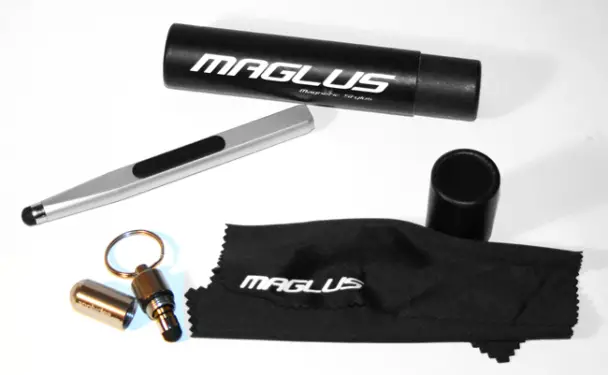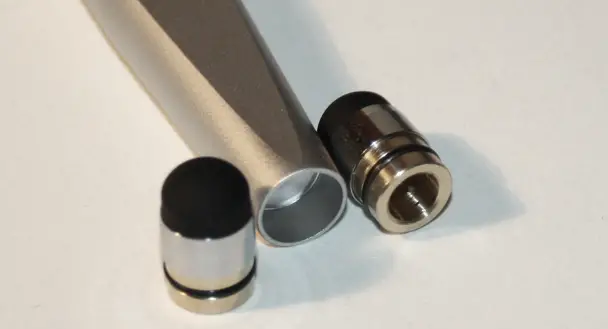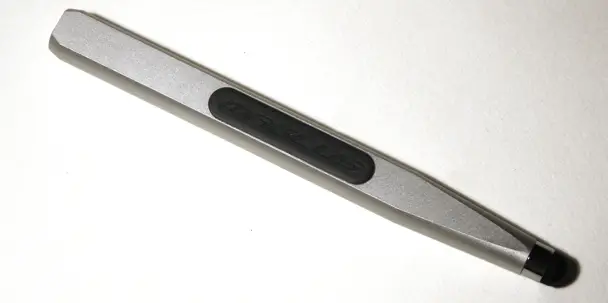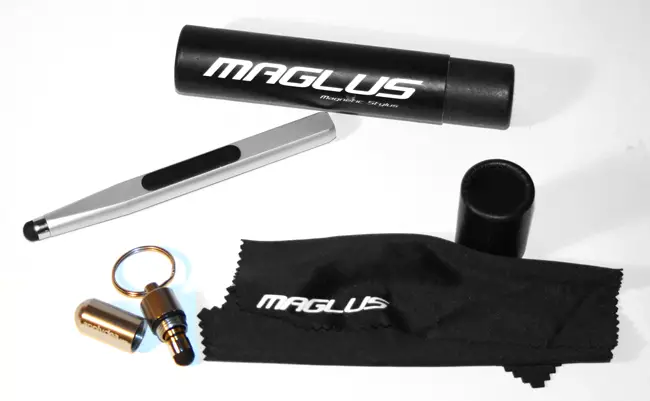Accessory review: Maglus stylus version 2

It’s been almost exactly a year since I reviewed the first Maglus. At that point it had just been launched, after a period of the creators trying to get it funded and manufactured. I gave it a glowing review, and it remains one of the best styli out there. So, what happens when you take one of the best styli on the market, and make a version 2? Read on to find out.
What’s in the box
The Maglus V2, or Maglus Stylus with Removable Tip System as it’s called on the site, differs from the first version in one very important area: the tip. This time around, it’s replaceable, which means that you can switch it out if it goes bad. To make sure you’re backed up from the start, the box comes with a replacement tip on top of the one that’s installed, as well as a keyring capsule to keep it in. The capsule is a branded version of the type of containers that are used for things like storing pills, keeping matches dry, or to name why I have several of them on my shelf, geocaching.

Other styli with replaceable tips tend to only make the actual rubber nib replaceable, and doesn’t come with a way to store the spare one(s), meaning that you’re lucky if you don’t lose it. The Maglus’ tip system actually involves switching out the entire tip, including the metal attachment ring, making the tips both more sturdy and unique when not in the stylus, and making them less fragile. The keyring capsule that comes with the Maglus is designed to keep the spare tip safe and within reach at all times, so that if the tip should break when you’re out and about, it’s right there. The capsule is actually capable of holding more than one tip, so when Applyidea starts offering spare tips in the store, you can keep more than one with you. This would though perhaps be more useful if there were different types of tips, like a brush tip for artists. One can always hope for the future – this update of the Maglus makes it a modular system, so it’s possible to release different types of tips in the future.
The Maglus V2 otherwise comes with what the V1 comes with, meaning the simple yet effective cardboard tube box, a cleaning cloth, and the Maglus itself. No-nonsense packaging, yet comes with everything you need. The Capsule actually doesn’t fit inside the cardboard tube, which is identical to that of the first Maglus, but since the Maglus is (as far as I know, could be wrong here) only sold online, this is solved by simply adding the capsule to the envelope it ships in.
Design
The new Maglus is essentially identical to the old Maglus, aside from the tip system. That means you have a stylus that’s flat on two sides of the body, with a rubber pad in the middle of each flat section, and rounded edges between them. It’s made of aluminum, so it matches the iPad quite well, and that’s also what the Maglus is primary made for. As a capacitive stylus it will of course work on a number of devices, but the magnets that hide underneath the rubber pads – which also give the Mag(netic sty)lus its name – are designed to stick to the iPad 2+’s Smart Cover.

The Maglus is thicker than a lot of styli being sold today, as shown in the video where I compare it to the Arctic Emote and the Wacom Bamboo. It’s actually in between those and the original AluPen as far as size goes. The size and weight isn’t random, and work towards the goal of creating a stylus with a tactile feel to it – which I’ll get to in a bit.
In use
In use, the Maglus V2 is great. The combination of a harder-than-most rubber nib and the weight of the stylus makes it easier to know when you’re actually interacting with the screen, which is a good thing. Some of my smaller styli are accurate, but suffer from a nib so soft that you’ve pushed it half through the screen by the time you notice you touched the screen. This makes the Maglus easier to be accurate with than the thinner nib styli in my opinion, which is a bit ironic.
Compared to the Maglus, using my smaller styli is almost like using a paint brush instead of a pen, because the nib is so soft you end up dragging it around. Again, those other styli aren’t inaccurate, far from it, my point here is just that the larger, stiffer Maglus stylus beats the smaller, softer Emote/Bamboo nibs.
As for the tip replacement system, I luckily haven’t had to use that for real, but just from testing it I can say that it works better than the systems that replace just the nib. The capsule container is also very helpful to have, as I actually know where the replacement tip is now.
As for the magnets, well, they work like they did in the first Maglus. It’s a great feature to have, so great that I added magnets to my Wacom stylus last year to make it more like the Maglus. I kinda go back and forth with styli, and I gave away my original Maglus to someone who needed a good stylus, but this time I’ll keep it for myself. With the amount of use my iPad gets these days, the iPad-specific magnets in the Maglus just makes it much easier to carry around than using the pen clip on the Emote or Bamboo.
Conclusion
There are so many different styli out there now that picking the right one involves answering question like “do I want a paint brush stylus” and “do I need an integrated ballpoint pen.” If you’re just after the stylus, however, I dare say the Maglus is among the best purchases you can make. I say “among the best,” because I hate absolute statements. At $25 euro it’s right in the middle as far as pricing goes, but when you consider that you’re getting a replacement tip that’s not just the rubber nib as part of that cost, I’d say it’s priced more than reasonably.
You can buy it directly from Applyidea, where you will also be able to get spare tips in the future – though these aren’t available quite yet.


